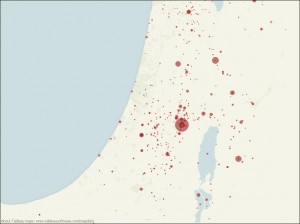
This is the third in a series of posts outlining the roadmap for MetaV, a database of people, places, passages, and periods of time found in the Bible.
In addition to a concordance, the back of your Bible will likely include a set of maps. Commonly you will find a map of Israel, Jerusalem, the Exodus, or Paul’s Missionary journeys. The data in MetaV is intended to help programmers dynamically create maps based on any set of passages selected. It comes from OpenBbile.info, which gives a latitude and longitude for every place mentioned in the Bible with a known location (or a well-educated guess).
Historical borders
The problem inherent in assigning every place a latitude and longitude is that it represents a country or region with a single place mark at that country’s capital or geographical center rather than drawing a border. While it has become an increasingly simple matter to overlay modern borders on a map, it is a monumental challenge to do so with historical borders.
One obvious reason for that is that we may not have a detailed map of those places from each time period. Another challenge is that instead of creating an overlay representing a single point in time, we must define borders for every period of that country’s history. Just look at how much Israel’s borders change from one century to the next! Fortunately, MetaV already includes a timeline which can be used to grab the right border overlay for that time period whenever someone manages to draw them.
Place Hierarchies
Cities are places unto themselves, but as borders shift they may be part of one empire in 400 B.C. and part of another empire in the first century A.D. What is needed, especially as an aid in (loosely) defining historical borders, is an explicit assignment of each landmark to a city, each city to a country, and each country to a region. Scholars know a lot of this already, it just needs to be systematized and gathered together so we can more easily answer questions like: “Was this city I’m reading about part of Rome or Babylon at the time this story took place?”
Ambiguous references
Just as people can be discussed with pronouns (he, she, they, etc), places can be referred to as “here”, “there”, etc. While it may be simple to understand where “here” is when reading the text, searches looking for “Jerusalem” may only find passages with that exact name. A more robust search to find all references to that specific city must have these ambiguous references defined.
The Modern World
MetaV is not only about linking people, places, and periods of time to the passages that tell their story; it is also about helping people see how the Bible relates to our world today. There are many resources which can give a wealth of data about places, including:religions, population, income, literacy rates, and government type. Consider a study on prophecy where you’re exploring the places that various prophets mentioned in relation to the end times. Wouldn’t it be helpful to know some things about how that country looks now when discerning where we may be on the prophetic timeline? These data can be integrated programmatically through tools like the Wolfram|Alpha API since the latitude and longitude are already defined.
Other Improvements
Like the names of people, names of places usually have a meaning behind them. J.B. Jackson’s Dictionary of Proper names will be a good place to start working up name meanings for places.
